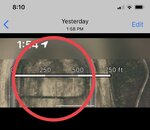I'd like to play around with calculating lateral g-force and Thill's turn 2 seems like a good place to experiment. Any comments or ridicule appreciated.
Last edited:
This site may earn a commission from merchant affiliate links, including eBay, Amazon, and others.
Lol. We need more people like you...On this planet.Any comments or ridicule appreciated.
The equation G = (V^2)/R is frequently encountered in discussions of the physics of racing. This simple formula can be confusing if you don’t realize that the G does not represent units of g-force but rather circular acceleration. To get units of g-force you must divide the acceleration given by the formula, by earth’s gravitation in appropriate units.
For example, I can sort of maintain 70 mph through Thunderhill’s turn 2
70 mph = 31.3 meters / second, The 325 feet radius of turn 2 is 99 meters
(31.3^2) / 99 = 9.895 meters / sec^2
Divide this result by earth’s gravitation which is 9.81 meters / sec^2 = 9.895 / 9.81 = 1.01 g
This result is obviously a nice starting place. Now I should be able to reach all kinds of goofy conclusions.
Interesting thought.I'd like to play around with calculating lateral g-force and Thill's turn 2 seems like a good place to experiment. Any comments or ridicule appreciated.
Interesting thought.
You might also want to have estimates for the radii to the actual driving line in two or three places . . . not sure how to come by those numbers, though.
Norm
